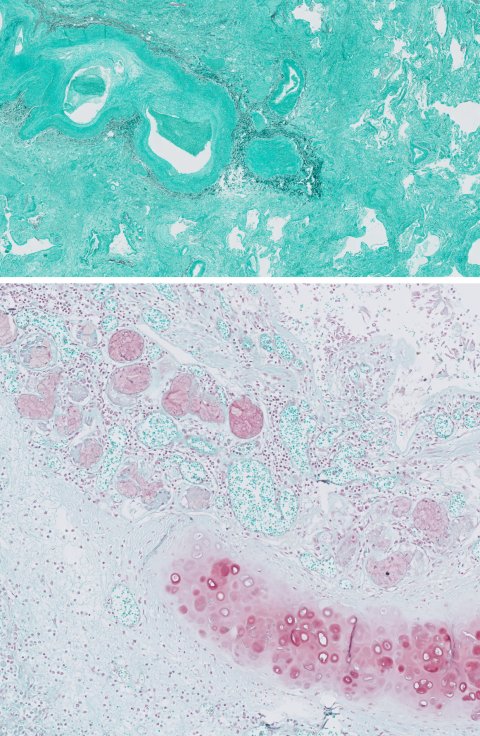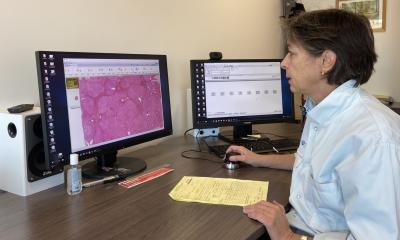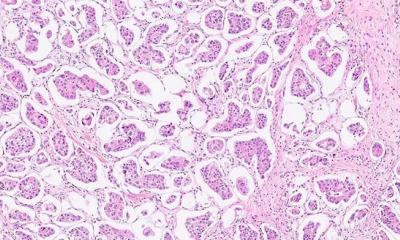Article • Experience report
Switch to digital pathology bears fruit
Fully digitising pathology operations has led to greater efficiency, cost savings, and quicker diagnosis for the Laboratory of Pathology East Netherlands (LabPON). The move, made six years ago, is showing measurable benefits and now, the institution is beginning to explore the potential of deep learning computational pathology algorithms, which might push the efficiency gains even further.
Report: Mark Nicholls

Image source: private
Details were outlined to the 8th Digital Pathology and AI Congress in London by Alexi Baidoshvili, Professor of Pathology, who specialises in digital and computational pathology at LabPON. He reported that LabPON had completely digitised its diagnostic routines for clinical cases in July 2015 and has continued to evolve the technology and processes ever since. Additional milestones were the development and introduction of AI software for image analysis in 2018 and a new Image Management System (IMS) in 2021, with further AI development and integration planned for 2022.
In his presentation, the expert discussed the investments necessary to introduce digital pathology. Areas to be considered include flow analysis in the laboratory, storage, scanners, the need for a robust IMS, training of staff, consultation workflows, software and enabling remote working. On average, setting up a laboratory for digital pathology requires at least 1.5 million euros per year, he calculated, with AI systems not included. However, investments might be a bit lower for institutions which already have a robust IT infrastructure in place. “It is very important to choose the right IMS,” he added, pointing out desirable features such as open architecture, integration with commonly used scanner types, robustness, scalability, support for external consultation and – not least – a user-friendly interface.
Safer, happier, more productive
Despite these initial hurdles, Prof Baidoshvili found the benefits from going digital to be well worth the effort for LabPON, which handles 55,000 histology, 20,000 cytology, 10,000 molecular and 12,000 immunohistochemistry cases per year: ‘What we have achieved from our investments is high efficiency and quality improvement,’ he said. Working with glass slides is a thing of the past, reducing the burden on logistics, streamlining workflows, and opening new possibilities for external consultations.

Image source: Baidoshvili
Pathologists’ workplaces also saw subsequent improvement, for example in enhanced safety, better service, and more flexibility, continued Baidoshvili. ‘In the future, there will be a move from subjective diagnosis to objective with AI applications.’ He emphasised how streamlined workflows were important in creating a ‘happier workplace’, leading to quicker replies to inquiries, faster and more efficient internal consultations and better support for multidisciplinary teams (MDTs). Digitisation also facilitated remote consultations, improved access to information and images, and better means to organise education and research.
Data from LabPON backs up these perceived improvements: for example, an experienced digital pathologist can diagnose faster via digital methods than with the conventional microscope. Time savings are significant, reported Baidoshvili, reducing the workload of pathologists and releasing time to perform other tasks, such as participation in multidisciplinary meetings. The expert noted that all staff segments benefit from this; lab personnel, technicians, and pathologists. Additionally, the switch from subjective to objective diagnosis led to savings on immunohistochemistry, improved service delivery to the clinic and patient, and yielded financial advantages. ‘The digital transition saves on archive time and the work of secretaries and of technicians,’ he added.
Current and future AI benefits
After transition to digital diagnosis, and the seamless integration of interoperable AI, Baidoshvili noted an ‘impressive’ accuracy of the system, for example in cancer detection and Gleason grading of cases. Referencing the lab’s experience with prostate AI solutions Concentriq from Proscia and Galen from Ibex, he praised their seamless and intuitive workflows, with initial results showing the potential to reduce immunohistochemistry costs, subject to further validation.
The expert also pointed out the potential of automatic report generation with AI assistance. ‘Thanks to AI, we can save 1:18 minutes of diagnostic time in every colon diagnosis.’ Applying this to the 500+ cases LabPON processed in 2020, Baidoshvili calculated more than 11 hours of saved diagnosis time for pathologists.
Overall, the switch to digitisation had widespread benefits with much improved logistics, handy tools in IMS resulting in high efficiency, flexible and remote working, easy access to computer archives, better and more efficient diagnostic quality and improved diagnostic logistics, leading to a happier pathology workforce.
Profile:
Alexi Baidoshvili is a Professor of Pathology at DT Medical University, Georgia. He specialises in digital and computational pathology at the Laboratory of Pathology East Netherlands (LabPON), an institution with 120 employees, 18 pathologists and 90 lab technicians. Furthermore, Prof Baidoshvili is an active board member of several international organisations and organiser of conferences. At LabPON, he and his team are working on the development of various image recognition programs.
03.03.2022










